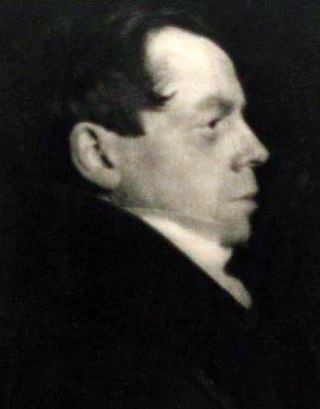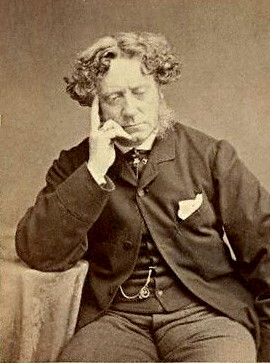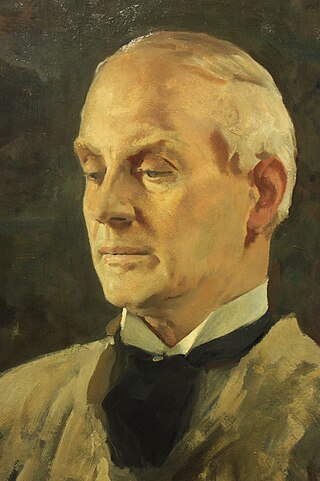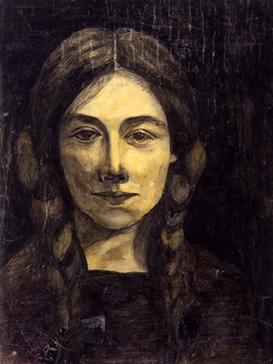
Alexander Runciman was a Scottish painter of historical and mythological subjects. He was the elder brother of John Runciman, also a painter.

Benjamin Lauder Nicholson, OM was an English painter of abstract compositions, landscapes, and still-life. He was one of the leading promoters of abstract art in his country.

Sir William Newzam Prior Nicholson was a British painter of still-life, landscape and portraits. He also worked as a printmaker in techniques including woodcut, wood-engraving and lithography, as an illustrator, as an author of children's books and as a designer for the theatre.

David Roberts was a Scottish painter. He is especially known for The Holy Land, Syria, Idumea, Arabia, Egypt, and Nubia, a prolific series of detailed lithograph prints of Egypt and the Near East that he produced from sketches he made during long tours of the region (1838–1840). These and his large oil paintings of similar subjects made him a prominent Orientalist painter. He was elected as a Royal Academician in 1841.

Sir Joseph Noel Paton was a Scottish artist, illustrator and sculptor. He was also a poet and had an interest in, and knowledge of, Scottish folklore and Celtic legends.

Rosa Winifred Nicholson was a British painter. She was married to the painter Ben Nicholson, and was thus the daughter-in-law of the painter William Nicholson and his wife, the painter Mabel Pryde. She was the mother of the painter Kate Nicholson.

Horatio McCulloch, sometimes written MacCulloch or M'Culloch, was a Scottish landscape painter.

Sir David Young Cameron was a Scottish painter and, with greater success, etcher, mostly of townscapes and landscapes in both cases. He was a leading figure in the final decades of the Etching Revival.

Christopher David George "Kit" Nicholson was a British architect and designer. His principal buildings of the 1930s show strong influences of the Rationalist and International Modernist architectural movements.

Robert Walker Macbeth was a Scottish painter, etcher and watercolourist, specialising in pastoral landscape and the rustic genre. His father was the portrait painter Norman Macbeth and his niece Ann Macbeth. Two of his five brothers, James Macbeth (1847–1891) and Henry Macbeth, later Macbeth-Raeburn (1860–1947), were also artists.

The Beggarstaffs, otherwise J. & W. Beggarstaff, was the pseudonym used by the British artists William Nicholson and James Pryde for their collaborative partnership in the design of posters and other graphic work between 1894 and 1899. They are sometimes referred to as the Beggarstaff Brothers, but did not use this name.

Charles Vacher (1818–1883) was a British painter in watercolours.

EQ Nicholson was an English painter and textile designer.

Mabel Scott Lauder Pryde was a Scottish artist, the wife of artist William Nicholson, and the mother of artists Ben Nicholson and Nancy Nicholson and the architect Christopher Nicholson.

Scottish art in the nineteenth century is the body of visual art made in Scotland, by Scots, or about Scottish subjects. This period saw the increasing professionalisation and organisation of art in Scotland. Major institutions founded in this period included the Institution for the Encouragement of the Fine Arts in Scotland, the Royal Scottish Academy of Art, the National Gallery of Scotland, the Scottish National Portrait Gallery and the Glasgow Institute. Art education in Edinburgh focused on the Trustees Drawing Academy of Edinburgh. Glasgow School of Art was founded in 1845 and Grays School of Art in Aberdeen in 1885.
The International Society of Sculptors, Painters and Gravers was a union of professional artists that existed from 1898 to 1925, "To promote the study, practice, and knowledge of sculpture, painting, etching, lithographing, engraving, and kindred arts in England or elsewhere...". It came to be known simply as The International. The society organised exhibitions, some for members only and some open to others, and social events such as musical evenings and soirées. The exhibitions were held in a number of London venues, and in other cities around England, including Nottingham and Manchester. Its founder and first president was James McNeill Whistler. On his death, the presidency was taken up by Auguste Rodin, with John Lavery as vice-president. The society contributed £500 towards the cost of Whistler's memorial.

The Grafton Galleries, often referred to as the Grafton Gallery, was an art gallery in Mayfair, London. The French art dealer Paul Durand-Ruel showed the first major exhibition in Britain of Impressionist paintings there in 1905. Roger Fry's two famous exhibitions of Post-Impressionist works in 1910 and 1912 were both held at the gallery.
Pat Douthwaite was a Scottish artist. She has been notably compared to Amedeo Modigliani and Chaïm Soutine, the peintres maudits of early twentieth-century Paris.
James Cowie was a Scottish painter and teacher. The quality of his portrait paintings and his strong linear style made him among the most individual Scottish painters of the 1920s and 1930s. His work displayed meticulous draughtsmanship which was based on his studies of the Old Masters and his use of many preparatory drawings.

Stansmore Richmond Leslie Dean Stevenson was a Scottish artist known for her oil paintings. She was a member of a group of women artists and designers known as the Glasgow Girls.


















